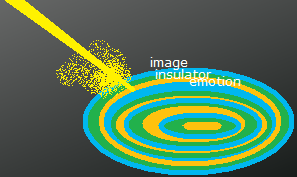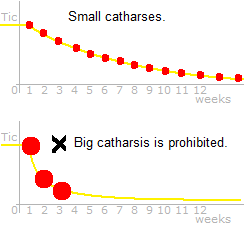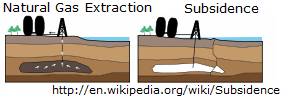The Kuriki method (the first edition in 2007) is a theory about Tourette’s syndrome (tic disorder) and obsessive-compulsive disorder to cure these diseases without medication. This theory is based on the author’s inference and interpretation regarding the structure of these diseases. Since it has been written for the psychoanalysts, reading will be difficult for people in general and it might be sometimes read erroneously. Therefore the Kuriki method must presuppose that the patient is treated by a nearby psychoanalyst, and that, between the patient and the Kuriki method, there is always the psychoanalyst. The explosion of emotional catharsis, which has strong repercussions, is done only for three seconds, once a week: beyond this rhythm, it would be an accident caused by negligence, and the psychoanalyst who is inexperienced in emotional catharsis must take responsibility for the temporary mental collapse caused by the accident. Also, to the patient who has weak capacity of logical reasoning, the psychoanalyst must explain well on the violent emotion of revenge caused by the illusory confusion between the person of the traumatic image in his head and the person in the real world.
Cure for Tourette’s syndrome (tic disorder) and OCD without medication
§35

Emotional catharsis (psychoanalysis)
[In English, pl. of the word “catharsis” is “catharses”.]
How to do catharsis.
Emotional catharsis is the principal treatment of tic disorder, the principal treatment of Tourette’s syndrome. The emotional catharsis requires intelligence for the eight reasons listed below.
(1) To be able to make an appointment with a doctor.
At least two or three times at the beginning, the emotional catharsis should be done with the help of a psychoanalyst in your neighborhood. For the treatment of a disease, the minimal expense should not be economized. I write with underline that the catharsis should be done with the help of a psychoanalyst. It is to keep a slow pace. The psychoanalyst is only the role of the brake. There are bad psychoanalysts who make explode a too strong emotion, as saying “Go! go!”, etc. It is important that the patient himself has understood the Kuriki method and has the will for healing.
Imitations of boxing with a pillow or a cushion are too explosive, therefore
prohibited.
Negative points of imitations of boxing.
· The bad psychoanalyst ignores the damage after a very big explosion.
· The bad psychoanalyst ignores the immensity of the mass of emotion.
· The bad psychoanalyst is in a hurry to show his ability to heal all at once.
For children
For children, emotional catharsis is not necessary. The cure is to explain in words the trauma at the libidinal level. If the child is excited, a day of rest. The child should be encouraged with words.
For adults
If the patient has a fragile psyche, the psychoanalyst can refuse emotional catharsis. Over a long period of about one year, the cure will be done only with verbalizations of the disagreeable judgments. But, unless the patient is a too sensitive person, he or she needs to do emotional catharsis in order to reduce the mass of emotion. Catharses is necessary.
The classic and authentic way of emotional catharsis.
The patient returns to the scene of the trauma at the libidinal level (an everyday repeated scene, perhaps); early childhood. He will express his emotion, this time. This is a very classical treatment. Expressing the image of the trauma and the emotion in words. It is necessary to verbalize the traumatic image and the disagreeable judgment as a grammatically complete phrase, because there is a little bit of “possibility” of tendency of Asperger. Of course, tic disorder is a neurosis, it is not a symptom of autism spectrum; it is obvious because tics are often transitory. To consider the relationship between the insulator of neurosis and the narrowing of the zone of objects of the Conscious in ADHD or in Asperger, the autistic spectrum varies too much. If the patient with autism has a tic, the question is the insulator, i. e., the repression of disagreeable judgments; not the movement of tic nor the « compulsive intramuscular sensation » of tic disorder.

(2) To mark the dates on the calendar.
The mass of emotion that is causing a nervous tic is hypertrophied. The catharsis will be done little by little. However, an explosion is an explosion, soft explosion does not exist, therefore, an explosion must be done as short as possible; just only three seconds. You should not bring out all at once. You should not blow all at once. When you get a small explosion, you stop already. Just only one small explosion of three seconds, once a week, regularly for three months, marking the dates on the calendar.
In a catharsis, you pull out your emotion intentionally. You do a catharsis with your will, as saying; “Well, now I want to do a blow of catharsis, because I still have a little bit of emotion.” A catharsis does not start by itself spontaneously. This too good insulation is the cause of the formation of a big mass of emotion.
(3) Consider the mass of emotion as a thing and understand its structure.
The reason why the patient with tic disorder needs to do catharsis is that the insulator under the traumatic image has a too good insulation and there is no leak of emotion. The patient keeps too much the accumulation. Even if he sees the traumatic image, the insulator envelopes the emotion too hermetically. The patient must drill a small hole with an emotional explosion to release the emotion. A mass of emotion is something like a tire. If you are just only looking at the tire, the air in the tire will not come out. You need make a tiny hole in order to release the air. There is a big difference with Freud’s psychoanalysis, which cures neurosis only with the discovery of the trauma and the description of its content.

(4) Do not make a big explosion.
The mass of emotion of a tic disorder is enormous. The emotional catharsis changes momentarily the balance of the Unconscious. The damage that is caused by a too rapid extraction is identical to the phenomenon of subsidence. The catharses should be advanced little by little, with recovery of the lost amount of psychic energy.
(5) Understand the structure of the feeling of anxiety caused by catharsis.
· Immediately after an explosion, the isolator will close and cover the exposed emotion. (In a minute).
· Because of the loss of mental balance, it may happen that you will feel anxiety, like after a blood donation, because the potential energy that existed no longer exists. (For 20 minutes). The anxiety after a catharsis is transient. It is a process of the healing of tic disorder. You observe calmly that it is due to a temporary imbalance of the Unconscious and you rest for 30 minutes on a bed. Big explosion is not necessary because once the trauma has been found, the trauma will never flee. It is not necessary to make a big explosion in a hurry.
· If you have found the image of the real trauma, even without doing intentional explosion, 5 minutes later, it may happen that you feel anxiety. You rest for 30 minutes on a bed.
(6) Interpret logically the image traumatic.
· During a catharsis, you will see the image traumatic in greater detail and know logically how the Unconscious interpreted, in fact, this trauma, differently than the Conscious did. You will see that the Unconscious had misunderstood something. The image that you see during a catharsis is extremely precious. If you see something new during a catharsis, you think logically the meaning the new image.
· The catharsis of the outer layers is necessary to attain the center of the mass of emotion. The emotion of the outer layer must be stronger than the emotion of the inner layer. Images and emotions encapsulate each other, like an onion. An image covers an emotion. An image hides the next image. You make a tiny hole on the image and through this hole the emotion emerges. Another image in more detail can appear in sight. Or a few days later, another image in more detail can appear. But, in most cases, as there are only three or four layers, it is not necessary to seek more.
· You go back to the age of 5. Before 5 years, it will be a logical imagination.
Also the center of mass of emotion can be a fear. An emotion of a baby about something intuitively and vitally grotesque of everyday. To heal tic disorder, it is not enough to find only the emotion of the center of the mass. You need to find the emotion with its enveloping image, the image of the thing, the image of the place.
Aggressive emotion; anger, enmity, accusation
Passive emotion; aversion, grief, fear, sadness
(7) Consider the traumatic aggressor as a virtual being, separate from the real person.
This person is a personage inside the patient’s head, and not the person who is outside the head.
(8) Emotional catharsis is a complex operation that requires all these controls listed above. It is an adventure that requires courage with caution.
Tourette syndrome (tic disorder) and obsessive-compulsive disorder
In treatment, the individual differences of the patient are meticulously taken into account. It takes about 30 minutes to observe the minimum state of subsidence and to confirm the following state of recovery. Extraction is quantitative; the limit is three seconds. In case of strong explosion, one second is enough. Since there is no spontaneity, strong explosion is intentionally strong, weak explosion is intentionally weak. The analyst observes the damage of the treatment knowing the lack of non-verbal communication and the avoidance of eye contact, etc. The explosion is done once a week. Three months later, the quatity of the fuel will be reduced, and the strong explosion will become impossible; there will be no risk of subsidence. For the treatment of a tic disorder, the effect of abreaction is already obvious at the first session of emotional explosion, the patient is obliged to wait one week before the second session.
In the first stage of treatment, since the quatity of fuel is enormous, there is a risk of explosion too strong. Therefore, it is necessary to limit the quatity of combustion by shortening the length of the explosion. Otherwise, even if the patient’s mental state seems to be very stable, subsidence will occur. The strength and length of explosion, the quatity of combustion of fuel, the state of subsidence; the patient himself learns these relationships. The patient observes the disappearance of the compulsivity in the mechanism of KV (Körperliche Verdrängung, bodily repression) which consists of the body sensation that is often specific in autistic spectrum.
The patient recognizes the state where the compulsivity quantitatively decreases in the compulsive physical sensation of his tic and of his obsessional idea. Thus, the patient can know that the abreaction is quantitative operation. Subsidence occurs immediately after a too strong explosion, however slow subsidence can occur with slow abreaction. Even if the stability is evident, the treatment of tic disorder and obsessive-compulsive disorder requires a week apart. The quantitative nature of abreaction must be taken into account.

